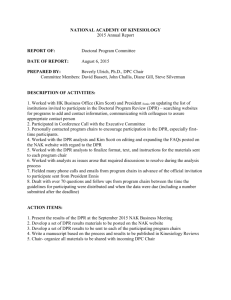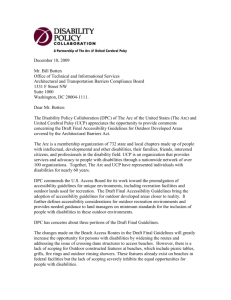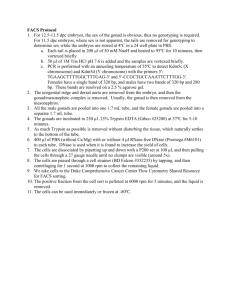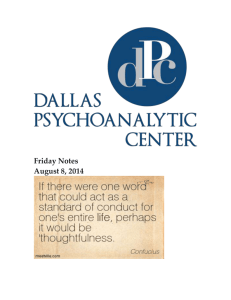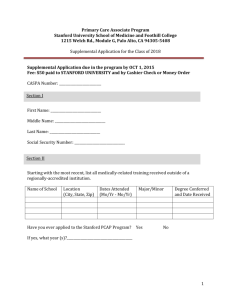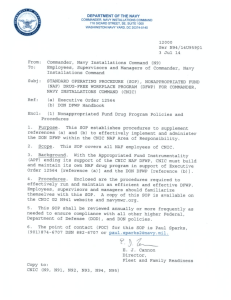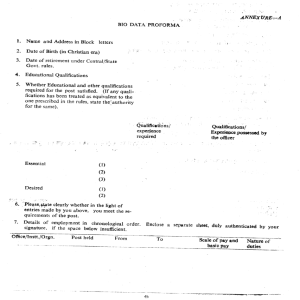Tetrahedron Letters,Vo1.26.No.48,pp 5951
advertisement
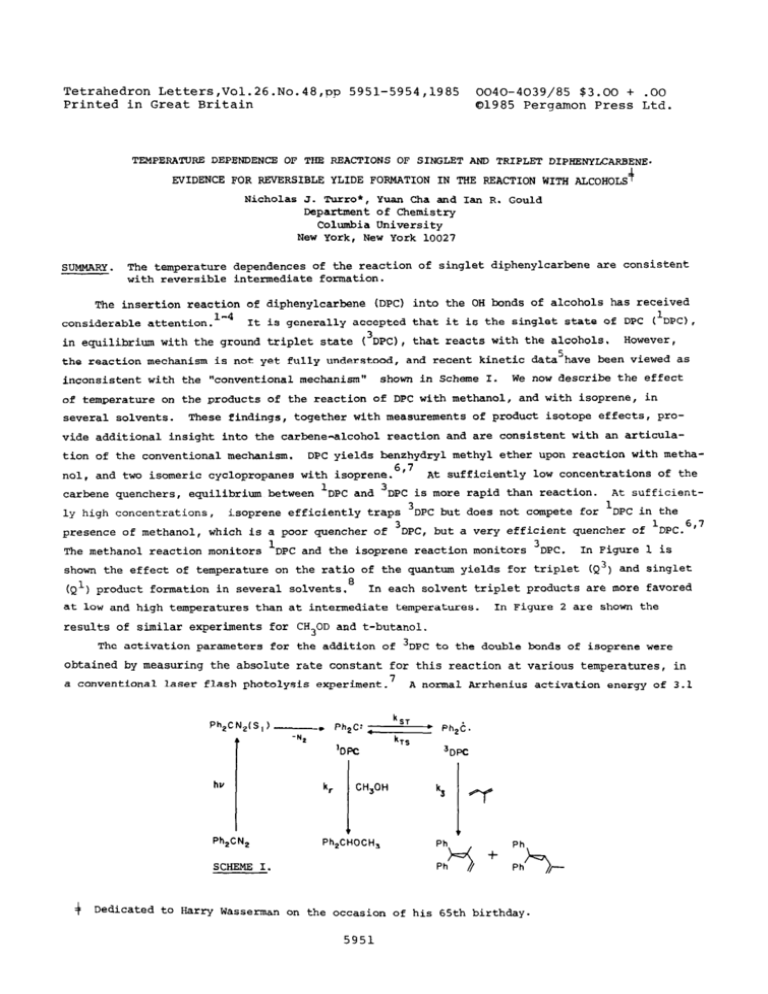
Tetrahedron Letters,Vo1.26.No.48,pp 5951-5954,1985 Printed in Great Britain 0040-4039/85 $3.00 + .OO 01985 Pergamon Press Ltd. TEWPERATLIREDEPENDENCE OF THE REACTIONS OF SINGLET AND TRIPLET DIPBENYLCARBENE. EVIDENCE FOR REVERSIBLE YLIDE FORMATION IN THE REACTION WITH ALCOHOLS+ Nicholas J. Turro*, Yuan Cha and Ian R. Gould Department of Chemistry Columbia University New York, New York 10027 SUMMARY. The temperature dependences of the reaction of singlet diphenylcarbeneare consistent with reversible intermediate formation. The insertion reaction of diphenylcarbene (DPC) into the OH bonds of alcohols has received considerable attention.1"4 It is generally accepted that it is the singlet state of DPC (lDPC), in equilibrium with the ground triplet state t3DPC), that reacts with the alcohols. However, the reaction mechanism is not yet fully understood, and recent kinetic data5have been viewed as inconsistent with the "conventionalmechanism" shown in Scheme I. We now describe the effect of temperature on the products of the reaction of DPC with methanol, and with isoprene, in several solvents. These findings, together with measurements of product isotope effects, provide additional insight into the carbene-alcoholreaction and are consistent with an articulation of the conventional mechanism. DPC yields benshydcyl methyl ether upon reaction with metha6,7 At sufficiently low concentrationsof the nol, and two isomeric cyclopropanes with isoprene. carbene quenchers, equilibrium between 'DPC and 3DPC is more rapid than reaction. At sufficient1 3 ly high concentrations, isoprene efficiently traps DPC but does not compete for DPC in the 1 3 6,7 presence of methanol, which is a poor quencher of DPC, but a very efficient quencher of DPC. 3 1 The methanol reaction monitors DPC and the isoprene reaction monitors DPC. In Figure 1 is shown the effect of temperature on the ratio of the quantum yields for triplet (Q3) and singlet (Ql) product formation in several solvents.* In each solvent triplet products are more favored at low and high temperatures than at intermediate temperatures. In Figure 2 are shown the results of similar experiments for CH30D and t-butanol. The activation parameters for the addition of 3DPC to the double bonds of isoprene were obtained by measuring the absolute rate constant for this reaction at various temperatures, in 7 a conventional laser flash photolysis experiment. A normal Arrhenius activation energy of 3.1 Ph,CN,fS,) -_-. Ph2C:. ‘NE Ph,CN, l Ph$. ‘bs ‘OPC r hv k.sT kr 3OPC CH,OH t Ph,CHOCH, SCHEME I. $ Dedicated to Barry Wasserman on the occasion of his 65th birthday. 5951 5952 kcal/mol -1 and pre-exponential factor of 2.8 x lo8 s were determined. The non-linear plots of Figures 1 and 2 are thus assigned to an unusual temperature dependence for the reaction of 'DPC with methanol. Temperature dependent aggregation of alcohols in solution is well known~' however, methanol and t-butanol are known to have very different aggre9 gation properties, but show essentially the same behavior in these experiments. We propose that these results can be interpreted in terms of the conventional mechanism with 1 DPC/alcohol is a reversibly formed dissociable .leadditional steps shown in eqns. 1 and 2. intermediate which is formed at a diffusion controlled rate (i.e., k =k In this case the 1 diff)' 1 DPC with an alcohol (kr) is not a simple constant, but observed rate constant for reaction of 1 DPC + alcohol = 1 DPC/alcohol 1 DPC/alcohol + ether kl , k-1 (1) k2 (2) is given in eqn. 3. This mechanism is identical to that previously proposed to account for the unusual temperature dependencies of the reactions of singlet phenylchlorocarbenewith alkenes,10 11 and also that which has been suggested for the reaction of singlet fluorenylidenewith alcohols. k, = klk2 (3) k-1 + k2 According to Scheme I the ratio Q3/Ql obeys eqn. 4.6,' k Q3/Q1 = st ktS + k3[IPl k3 [IPI X = H,D (4) kr ~Roxl kst is known and is assumed to have zero temperature dependence,7 It is further assumed that the temperature dependence of kts can be calculated using the known free energy difference 7 between the triplet and singlet states of DPC. Thus, the temperature dependence of kr can be determined at each experimental temperature, and is shown in Figure 3 for three alcohols in isooctane. Above -lOOC, kr increases as the temperature decreases, a situation which is commonly observed for the kinetic situation of egns. 1 and 2. At lower temperatures kr decreases, Presumably as it becomes determined by the rate of diffusion (kl) in the solvent." The kinetic scheme is supported by the observed isotope effects. At low temperatures the reaction rate is determined by the competition between reversal to starting materials and reaction from the intermediate. An intermediate which is consistent with both the present results 3 and previous proposals, is an ylide species in which the vacant carbenic p orbital interacts with the lone-pair electrons of the alcohol, Reaction from the ylide involves a proton transfer and should, thus, exhibit a secondary isotope effect. At low temperatures the reaction becomes dominated by the rate of diffusion, and therefore the isotope effect is significantly reduced. The dramatic solvent effect is due to the difference in energy between the ground state 7,12 3 The energy difference is smaller DPC and 'DPC, which is known to be solvent dependent. in polar solvents, such as CH3CN, which results in an increased yield of the singlet ether product. In non-polar solvents, such as isooctane, a larger energy gap results in more of the 5953 cyclopropane triplet products. In view of the assumptions involved in the calculations, the temperature dependences of kr shown in Figure 3 should be considered to be qualitative rather than quantitative. Certainly no information concerning the structure of the intermediate can be drawn from the kinetic analysis. However, it is encouraging that the qualitative behavior in kr is similar to that previously observed in the absolute rate behavior of other singlet carbene reactions.10 Figure 1. Figure 2. Plots of temperature dependence of the reaction of DPC with methanol and isoprene in several solvents. tPh2CN21 = 1.5 mM; [CH30Hl = 0.005 M; [IPI = l M. Plots of temperature dependence of the reaction of DPC with alcohols and isoprene in isooctane. [Ph2CN21 = 1.5 mM; [alcohol]= 0.05 M; [IPI = 1 M. 5954 25.00 t Rnkr 24.00 23.00 I I Figure ACKNOWLEDGEMENTS. Schuster, helpful University Foundation for support of Illinois, 2. D. Bethell, G. Stevens, A.R. Newall, "Carbene Chemistry", 3. D. Bethell, G.L. Gloss and B.E. Rabinow, 5. D. Griller, 6. K.B. Eisenthal, A. Nasran Degassed and D. Whittaker, J. Am. Chem. 9. 10. of his related research and for through Academic Press, New York 1971. J. Chem. Sot. 1970, 792. (B), 1971, 23. Sot., 1976, %,8190. J.A. Butcher, and M.J. McAuliffe, Jr., C. Dupuy, G. Hefferon, J. Am. Chem. Sot. 1980, z, I.R. Gould, G. Hefferon, W. Hether- 6563. J. Langan, and Y. Cha, 41, 1543. of diphenyldiazomethane Pyrex at various and bensophenone H. Iandeck, and , and J.C. Scaiano, J. Am. Chem. Sot. 1984, 106, 198. of the yields of the cyclopropanes methane Research They also thank Prof. Gary B. J. Chem. Sot. Chem. Commun. N.3. Turro, E.V. Sitsmann, 1985, solutions irradiated 1 DPC with of AND NOTES N.J. Turro, M. Aikawa, G.M. Korenowski, K.B. Eisenthal, a preprint 2nd edition, and P. Tickle, 4. 8. of the reaction of this research. for providing REFERENCES W. Kirmse, Tetrahedrs_, dependence 5. 0 5.00 1,T x103- and suggestions. 1. 7. 4.50 The authors wish to thank the Air Force Office of Scientific Science discussions ington, I 4.00 Arrhenius plots of the temperature alcohols in isooctane. 3. the National I 3.50 5.00 (1.5mM), methanol temperatures. Product and ether was >95%. (5OmM), and isoprene analysis was by GLC. Minor quantities (lo) were The sum of diphenyl- were also detected. H. Wolff, and R.J. Gets, N.J. Turro, G. Lehr, J.A. Butcher, J. Phys. Chem. 1977, E, 718. Jr., R.A. Moss, and W. Guo, J. Am. Chem. SOc. 1982, 104 1754. 11. J.J. Zupancic, P.B. Grasse, S.C. Lapin, and G.B. Schuster, 12. E.V. Sitzmann, J.G. Langan, and K.B. Eisenthal, (Received USA 1985) in 8 July Tetrahedron, 1985, 41, 1471. J. Am. Chem. Sot. 1984, 106, 1868.


